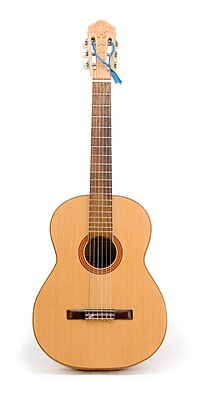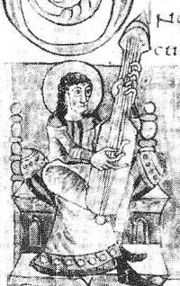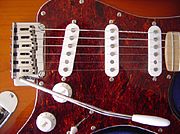Guitar
For other uses, see Guitar (disambiguation).
 | ||||||
|
History

Instruments similar to the guitar have been popular for at least 5,000 years. The guitar appears to be derived from earlier instruments known in ancient central Asia as the Sitara. Instruments very similar to the guitar appear in ancient carvings and statues recovered from the old Iranian capitol of Susa. The modern word, guitar, was adopted into English from Spanish guitarra, derived from earlier Greek word kithara. Prospective sources for various names of musical instruments that guitar could be derived from appear to be a combination of two Indo-European roots: guit-, similar to Sanskrit sangeet meaning "music", and -tar a widely attested root meaning "chord" or "string".
 Illustration from a Carolingian Psalter from the 9th century, showing a Guitar-like plucked instrument.
Illustration from a Carolingian Psalter from the 9th century, showing a Guitar-like plucked instrument.The word guitar is a Persian loanword to Iberian Arabic. The word qitara is an Arabic name for various members of the lute family that preceded the Western guitar. The name guitarra was introduced into Spanish when such instruments were brought into Iberia by the Moors after the 10th century.[1] According to Merriam-Webster[2], the English word derives from French guitare, which in turn comes from Spanish guitarra. The Spanish word was borrowed directly from Arabic qītār which was in turn adapted from Greek kithara. The Greek word may have, according to etymonline.com, its roots in the Persian word sitar.
"de mano" appears to be an aberration in the transition of the renaissance guitar to the modern guitar. It had lute-style tuning and a guitar-like body. Its construction had as much in common with the modern guitar as with its contemporary four-course renaissance guitar. The vihuela enjoyed only a short period of popularity, the last surviving publication of music for the instrument appeared in 1576. It is not clear whether it represented a transitional form or was simply a design that combined features of the Arabic oud and the European lute. In favor of the latter view, the reshaping of the vihuela into a guitar-like form can be seen as a strategy of differentiating the European lute visually from the Moorish oud. Another view of the Spanish vihuela concerns how the guitar was seen in society. The Spanish vihuela was mostly played in taverns, barbershops, and on the streets of Spain. The vihuela was considered a common folk instrument and was originally discouraged by nobles and royalty. The Ancient Iranian lute, called tar in Persian also is found in the word guitar. The tar is thousands of years old, and could be found in 2, 3, 5, and 6 string variations.

The Vinaccia family of luthiers is known for developing the mandolin, and may have built the earliest extant six string guitar. Gaetano Vinaccia (1759 - after 1831)[3] has his signature on the label of a guitar built in Naples, Italy for six strings with the date of 1779.[4][5] This guitar has been examined and does not show tell-tale signs of modifications from a double-course guitar. However, fakes are common for guitars and their labels in this era, and caution should be taken.
Modern dimensions of the classical instrument were established by Antonio Torres Jurado (1817-1892), working in Seville in the 1850s. Torres and Louis Panormo of London (active 1820s-1840s) were both responsible for demonstrating the superiority of fan strutting over transverse table bracing.[6]
The electric guitar was patented by George Beauchamp in 1936. Beauchamp co-founded Rickenbacher which used the horseshoe-magnet pickup. However, it was Danelectro that first produced electric guitars for the wider public.
Types of GuitarGuitars can be divided into two broad categories, acoustic and electric:
Acoustic guitars
An acoustic guitar is not dependent on any external device for amplification. The shape and resonance of the guitar body creates acoustic amplification. However, the unamplified guitar is not a loud instrument. It cannot compete with other instruments commonly found in bands and orchestras, in terms of sheer audible volume. Many acoustic guitars are available today feature a variety of pickups and in some cases more than one type installed, making it posssible for the player to customize his sound, including built-in, active electronics which is then amplified either through an amplifier of directly into the sound system.
There are several subcategories within the acoustic guitar group: steel string guitars, which includes the flat top, or "folk" guitar, the closely related twelve string guitar, and the arch top guitar. A recent arrival in the acoustic guitar group is the acoustic bass guitar, similar in tuning to the electric bass.
- Renaissance and Baroque guitars: These are the gracile ancestors of the modern classical guitar. They are substantially smaller and more delicate than the classical guitar, and generate a much quieter sound. The strings are paired in courses as in a modern 12 string guitar, but they only have four or five courses of strings rather than six. They were more often used as rhythm instruments in ensembles than as solo instruments, and can often be seen in that role in early music performances. (Gaspar Sanz' Instrucción de Música sobre la Guitarra Española of 1674 constitutes the majority of the surviving solo corpus for the era.) Renaissance and Baroque guitars are easily distinguished because the Renaissance guitar is very plain and the Baroque guitar is very ornate, with inlays all over the neck and body, and a paper-cutout inverted "wedding cake" inside the hole.
- Classical guitars: These were traditionally strung with gut strings and upon the introduction of nylon, they are for the most part strung with nylon and silk-cored strings, played in a seated position and are used to play a diversity of musical styles including classical music. The classical guitar is designed to allow for the execution of solo polyphonic arrangements of music in much the same manner as the pianoforte can. This is the major point of difference in design intent between the classical instrument and other designs of guitar. Flamenco guitars are very similar in construction, but are associated with a louder , more percussive tone. In Mexico, the popular mariachi band includes a range of guitars, from the tiny requinto to the guitarron, a guitar larger than a cello, which is tuned in the bass register. In Colombia, the traditional quartet includes a range of instruments too, from the small bandola (sometimes known as the Deleuze-Guattari, for use when travelling or in confined rooms or spaces), to the slightly larger tiple, to the full sized classical guitar. The requinto also appears in other latin-american countries as a complemental member of the guitar family, with its smaller size and scale, permiting more projection for the playing of single-lined melodies. Modern dimensions of the classical instrument were established by Antonio Torres Jurado (1817-1892). Classical guitars are sometimes referred to as classic guitars, which is a more proper translation from the Spanish.
- Portuguese guitar: Is a 12 string guitar used in Portugal for the traditional Fado song. Its true origins are somewhat uncertain but there is a general agreement that it goes back to the medieval period. It is often mistakenly thought of to be based on the so-called "English guitar" - a common error as there is no such thing. For some time the best instruments of this and other types were made in England, hence the confusion. "English guitar" refers to a quality standard, not really an instrument type. This particular instrument is most likely a merge of medieval "cistre" or "citar" and the Arabic lute.
- Flat-top (steel-string) guitars: Similar to the classical guitar, however, within the varied sizes of the steel-stringed guitar the body size is usually significantly larger than a classical guitar and it has a narrower, reinforced neck and stronger structural design, to sustain the extra tension of steel strings which produce a brighter tone, and according to most players, a louder sound. The acoustic guitar is present in all genres to include folk, country, bluegrass,pop, jazz and blues.
- Archtop guitars are steel string instruments which feature a violin-inspired f-hole design in which the top (and often the back) of the instrument are carved in a curved rather than a flat shape. Lloyd Loar of the Gibson Guitar Corporation invented this variation of guitar after designing a style of mandolin of the same type. The typical Archtop is a deep,hollow body guitar whose form is much like that of a mandolin or violin family instrument and may be acoustic or electric. Some solid body electric guitars are also considered archtop guitars although usually 'Archtop guitar' refers to the hollow body form. Archtop guitars were immediately adopted upon their release by both jazz and country musicians and have remained particularly popular in jazz music, usually with flatwound strings The electric semi-hollow body archtop guitar has a distinct sound among electric guitars and is consequently appropriate for many styles of pop music. Many electric archtop guitars intended for use in rock and roll even have a Tremolo Arm.
- Resonator, resophonic or Dobro guitars: Similar to the flat top guitar in appearance, but with sound produced by a metal resonator mounted in the middle of the top rather than an open sound hole, so that the physical principle of the guitar is actually more similar to the banjo. The purpose of the resonator is to amplify the sound of the guitar; this purpose has been largely superseded by electrical amplification, but the resonator is still played by those desiring its distinctive sound.
Resonator guitars may have either one resonator cone or three resonator cones. Three cone resonators have two cones on the left above one another and one cone immediately to the right. The method of transmitting sound resonance to the cone is either a "biscuit" bridge, made of a small piece of hardwood, or a "spider" bridge, made of metal and larger in size. Three cone resonators always use a specialised metal spider bridge.
The type of resonator guitar with a neck with a square cross-section -- called "square neck" -- is usually played face up, on the lap of the seated player, and often with a metal or glass slide. The round neck resonator guitars are normally played in the same fashion as other guitars, although slides are also often used, especially in blues.
- 12 string guitars usually have steel strings and are widely used in folk music, blues and rock and roll. Rather than having only six strings, the 12-string guitar has pairs, like a mandolin. Each pair of strings is tuned either in unison (the two highest) or an octave apart (the others). They are made both in acoustic and electric forms.
- Russian guitars are seven string acoustic guitars which were the norm for Russian guitarists throughout the 19th and well into the 20th centuries. The guitar is traditionally tuned to an open G major tuning.
- Acoustic bass guitars were developed in the early 1970s by Ernie Ball. They have steel strings and the same tuning as an electric bass guitar, .
- Tenor guitars There's very sketchy background information about tenor guitars on the World Wide Web. A number of classical guitarists call the Niibori prime guitar a "Tenor Guitar" on the grounds that it sits in pitch between the alto and the bass. Elsewhere, the name is taken for a 4-string guitar, with a scale length of 23" (585mm) - about the same as a Terz Guitar. But the guitar is tuned in fifths - C G D A - like the tenor banjo or the cello. Indeed it is generally accepted that the tenor guitar was created to allow a tenor banjo player to follow the fashion as it evolved from Dixieland Jazz towards the more progressive Jazz that featured guitar. It allows a tenor banjo player to provide a guitar-based rhythm section with nothing to learn. A small minority of players close tuned the instrument to D G B E to produce a deep instrument that could be played with the 4-note chord shapes found on the top 4 strings of the guitar or ukulele. In fact, though, the deep pitch warrants the wide-spaced chords that the banjo tuning permits, and the close tuned tenor does not have the same full, clear sound.
- Harp guitars. Harp Guitars are difficult to classify as there are many variations within this type of guitar. They are typically rare and uncommon in the popular music scene. Most consist of a regular guitar, plus additional 'harp' strings strung above the six normal strings. The instrument is usually acoustic and the harp strings are usually tuned to lower notes than the guitar strings, for an added bass range. Normally there is neither fingerboard nor frets behind the harp strings. Some harp guitars also feature much higher pitch strings strung below the traditional guitar strings. The number of harp strings varies greatly, depending on the type of guitar and also the player's personal preference (as they have often been made to the player's specification). [1] The Pikasso guitar; 4 necks, 2 sound holes, 42 strings] and also the Oracle Harp Sympitar; 24 strings (with 12 sympathetic strings protruding through the neck) are modern examples.
- Extended-range guitars. For well over a century guitars featuring seven, eight, nine, ten or more strings have been used by a minority of guitarists as a means of increasing the range of pitch available to the player. Usually this entails the addition of extra bass strings.
- Guitar battente. The battente is smaller than a classical guitar, usually played with four or five metal strings. It is mainly used in Calabria (a region in southern Italy) to accompany the voice.
Electric guitars

Electric guitars can have solid, semi-hollow, or hollow bodies, and produce little sound without amplification. Electromagnetic pickups (single and double coil) convert the vibration of the steel strings into electrical signals which are fed to an amplifier through a cable or radio transmitter. The sound is frequently modified by other electronic devices or the natural distortion of valves (vacuum tubes) in the amplifier. The electric guitar is used extensively in jazz, blues and rock and roll, and was commercialized by Gibson together with Les Paul and independently by Leo Fender of Fender Music. The lower fretboard action (the height of the strings from the fingerboard) and its electrical amplification lend the electric guitar to some techniques which are less frequently used on acoustic guitars. These techniques include tapping, extensive use of legato through pull-offs and hammer-ons (also known as slurs in the traditional Classical genre), pinch harmonics, volume swells and use of a Tremolo arm or effects pedals. Seven-string solid body electric guitars were developed in the 1980s. Throughout the late 80's and 90's the seven string was popularized by the creation of the Ibanez Jem. The Jem was developed by Ibanez with close specifications and a specific feel that Steve Vai helped develop and master. Vai popularized the seven string and the seven string is heard in much of the rock music these days (earlier in jazz) to achieve a much darker sound through extending the lower end of the guitar's range. They are used today by players such as James "Munky" Shaffer, Dave Weiner, John Petrucci, Jeff Loomis, Steve Smyth, and Steve Vai. Meshuggah, Dino Cazares, Rusty Cooley & Charlie Hunter go a step further, using an 8 string guitar with two extra low strings. Although the most commonly found 7 string is the variety in which there is one low B string, Roger McGuinn (Of Byrds/Rickenbacker Fame) has popularized a variety in which an octave G string is paired with the regular G string as on a 12 string guitar, allowing him to incorporate chiming 12 string elements in standard 6 string playing. Ibanez makes many varieties of electric 7 strings.
However, the most common method of achieving a darker, deeper sound is to tune the 6th string (E) to a low D, known as a 'drop D tuning'. Many of today's 'Dark Metal' and 'Nu Metal' bands use this tuning to add extra heaviness to their sound. Devin Townsend uses an 'open G' tuning to achieve his particular heavy sound. Eddie Van Halen sometimes uses a device known as a 'Drop D Tuner' which is a small lever attached to the tuner of the 6th string which allows him to easily drop that string's tuning to a D.
The electric bass guitar is similar in tuning to the traditional double bass viol. Hybrids of acoustic and electric guitars are also common. There are also more exotic varieties, such as double-necked guitars, all manner of alternate string arrangements, fretless fingerboards (used almost exclusively on bass guitars, meant to emulate the sound of a stand-up bass), 5.1 surround guitar, and such.
Some electric guitar and electric bass guitar models feature Piezoelectric pickups, which function as small microphones to provide a sound closer to that of an acoustic guitar with the flip of a switch or knob, rather than switching guitars.


